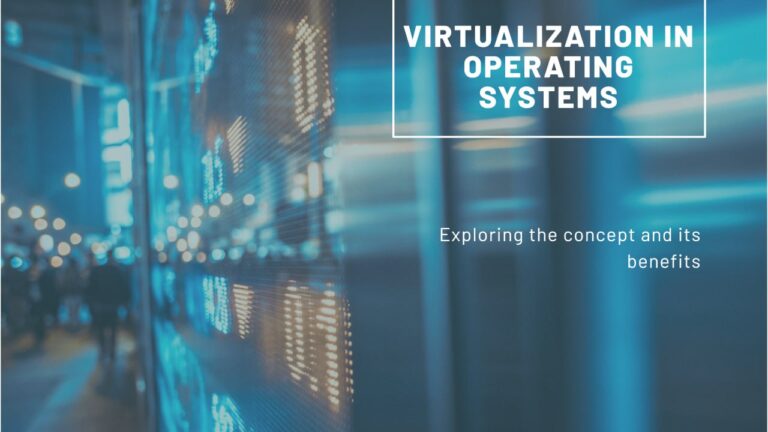In the ever-evolving realm of technology, virtualization stands out as a revolutionary concept that has transformed the landscape of computing. By abstracting physical resources into virtual entities, virtualization enables organizations to optimize efficiency, enhance flexibility, and drive innovation across various domains. In this blog, we’ll embark on a journey to unravel the intricacies of virtualization, from its fundamental principles to its diverse applications and profound impact on modern IT environments.
Understanding Virtualization:
Unlock the power of virtualization with this comprehensive guide that delves into the core principles, benefits, types, technologies, and practical applications of virtualization. Learn how virtualization abstracts computing resources from physical hardware, enabling organizations to maximize efficiency, scalability, and cost savings. Explore various types of virtualization, including hardware, software, network, and storage virtualization, and discover key technologies such as hypervisors, containers, and virtual desktop infrastructure (VDI). Whether you’re a seasoned IT professional or a curious novice, this guide will equip you with the knowledge and insights needed to harness the full potential of virtualization in today’s digital world.

Applications of Virtualization:
Server Virtualization:
- By consolidating multiple virtual servers onto a single physical server, organizations can optimize hardware utilization, reduce costs, and simplify management tasks.
- Virtualization enables dynamic provisioning of resources, allowing for scalable and flexible deployment of applications and services.
Network Virtualization:
- Virtualized networks abstract the underlying physical infrastructure, enabling organizations to create logical network segments, implement security policies, and optimize traffic routing.
- Network virtualization facilitates the creation of virtual private networks (VPNs), virtual LANs (VLANs), and software-defined networking (SDN) architectures.
- Storage Virtualization:
- With storage virtualization, organizations can pool and abstract storage resources from disparate storage devices, providing centralized management and simplified provisioning.
- Virtualized storage environments offer features such as data deduplication, snapshotting, and replication, enhancing data availability and disaster recovery capabilities.
- Desktop Virtualization:
- Desktop virtualization delivers virtual desktops to end-users, enabling access to personalized computing environments from any device, anywhere.
- Organizations benefit from centralized desktop management, improved security, and enhanced flexibility for remote work and mobility initiatives.
- Cloud Computing: Cloud platforms leverage virtualization to deliver scalable and on-demand computing resources over the internet. Infrastructure as a Service (IaaS) providers use virtualization to partition physical servers into virtual instances, while Platform as a Service (PaaS) and Software as a Service (SaaS) offerings run on virtualized infrastructure.
Resource Optimization and Scalability: Virtualization allows organizations to dynamically allocate and reallocate computing resources based on demand. This improves resource utilization, scalability, and flexibility, enabling organizations to scale their IT infrastructure up or down quickly in response to changing business needs.
Legacy Application Support: Virtualization enables organizations to run legacy applications on modern hardware without compatibility issues. By encapsulating legacy applications within virtual machines, organizations can extend the lifespan of legacy systems while transitioning to newer technologies.
High-Performance Computing (HPC): Virtualization is increasingly being used in HPC environments to improve resource utilization and manage complex computing workloads. Virtualization technologies such as GPU virtualization and high-performance networking enable organizations to achieve greater efficiency and performance in HPC clusters.
Advantages of Virtualization:
- Cost Savings: Reduced hardware and energy costs.
- Improved Resource Utilization: Efficient use of computing resources.
- Scalability and Flexibility: Easily adapt to changing demands.
- Enhanced Disaster Recovery: Faster recovery and business continuity.
- Simplified Management: Centralized control and automation.
- Increased Agility: Faster deployment of new applications.
- Security and Isolation: Enhanced protection against threats.
- Legacy Application Support: Compatibility with older software.
CONCLUSION
Virtualization revolutionizes IT infrastructure by abstracting physical hardware into virtual instances, optimizing resource utilization, enhancing flexibility, and cutting costs. It allows running multiple virtual machines on a single physical server, reducing hardware expenses and environmental impact. Virtualization enables quick provisioning, scaling, and migration of resources to meet changing business needs, fostering agility and responsiveness. Security is bolstered through isolation of workloads, while features like snapshotting and replication ensure robust disaster recovery. As businesses embrace digital transformation, virtualization remains a pivotal technology driving innovation and efficiency in the dynamic digital landscape.